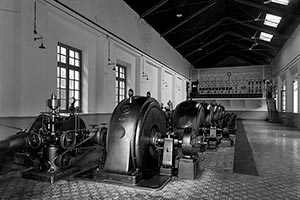Hydroelectric power plants in the Bidasoa basin
Almandoz Power Station - Puente Marín
The Puente Marín hydroelectric power plant was the most powerful in Navarre from 1912 until 1930, when the Alloz plant was put into service. It was built 150 meters from the bridge over the Marín stream, over which the old N-121 used to run, once the town of Almandoz had been passed in the direction of France. The water comes from several races in Velate through a channel of more than seven kilometers long, which is traced through steep terrain, making it necessary to excavate several tunnels. The waterfall is more than four hundred meters high, at that time one of the highest in Spain. This technical feat was carried out by the engineer Miguel Berazaluce at partnership with the contractor Norberto Elberdin.
Berazaluce exposed his project in an expositoryreport on the use of a hydraulic exploitation in the regatta of Marín (1911), in which he publicized the advantages of the business to possible investors. Among others, he highlighted the location, optimal to face the problem of low water levels and close to the Guipuzcoa market. No material means were spared to erect a grandiose power plant with state-of-the-art machinery contracted with Siemens Schuckert - Industria Eléctrica, the same supplier of the main companies in the sector in Spain. The inauguration was celebrated in the palace of Reparacea with a succulent banquet followed by the toast of Ramón María del Valle-Inclán, who used his oratory to express his love for Navarra.
Electra Puente Marín was one of the main companies with Navarrese capital set up to supply energy to Guipúzcoa. Its customers were the Compañía del Ferrocarril de San Sebastián a Hernani, which received power through the power station it owned in Zubieta, and La Papelera Española, for its factory in Rentería. The latter company would become the only customer after 1924 and even acquired Electra Puente Marín in the fifties through its subsidiary Saltos del Bidasoa.
The powerhouse building is striking for its vigorous presence, which is a reflection of the magnitude of this business initiative. In addition to its great height, it has a wide rectangular floor plan, which originally housed five units - today it has six. Seven large linteled openings open on the western wall to the turbine conference room . The decoration is restrained, concentrated in the window frames, under the eaves (rectangular and corbelled motifs) and in a large strip where the name of the developer's company was painted in giant letters. The short north-facing façade has an ascending crown of broken profile and the facing is articulated by vertical and horizontal bands. The access gate is crowned by a curved pediment that surrounds the inauguration date and above it there is an oculus, a typical element in industrial architecture. All this decoration is arranged in slight relief and in bichrome. The impression when looking inside is that its current appearance, with the old machinery and the original geometric design pavement, is not very different from the one captured by the photographer Zaragüeta one hundred years ago.
ALEGRÍA SUESCUN, D., "El molino harinero de Zubieta. Evolución histórica", in Notebooks of ethnology and ethnography of Navarren.º 82 (2007), pp. 5-15.
APEZTEGUÍA ELSO, M. and IRIGARAY SOTO, S., "El Ecomuseo del Molino de Zubieta (Navarra): experiencia pionera en la recuperación y musealización de una instalación preindustrial", in Museum: Magazine of the association Profesional de Museólogos de España (Professional Association of Museologists of Spain)No. 4 (1999), pp. 181-192.
BERAZALUCE ELCARTE, M., "La industria hidro-eléctrica en Navarra", in Rafael Guerra (ed.), Navarra. Ayer, hoy y mañana, Pamplona, Diputación Foral de Navarra, 1933.
HERREROS LOPETEGUI, S. (coord.), Centrales Hidroeléctricas en Navarra (1898-2018), Pamplona, Gobierno de Navarra, 2020.
Map of status based on El agua en Navarra, Pamplona, Caja de Ahorros de Navarra, 1991.











